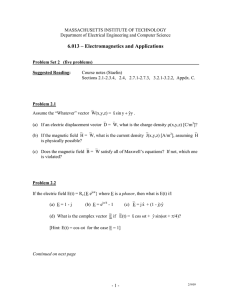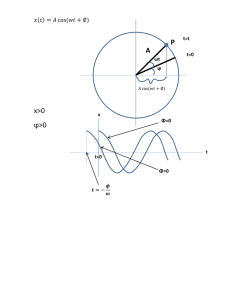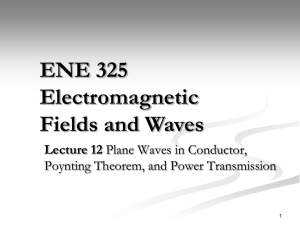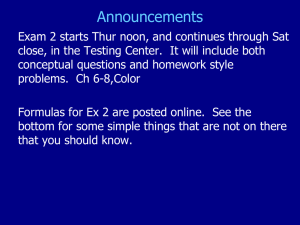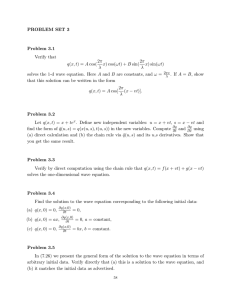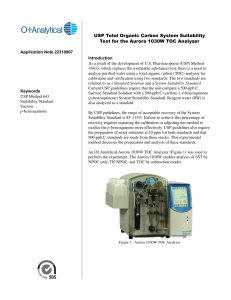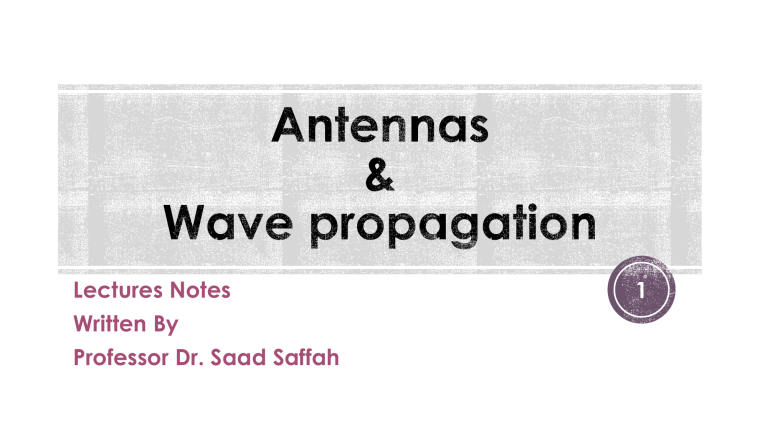
Lectures Notes Written By Professor Dr. Saad Saffah 1 ( ) ( ) 1 2 1 2 E H dS = − J E dv − E dv − H dv t 2 t 2 ▪ The cross product in the left-hand side can be written as following and known as instantaneous Poynting vector P = EH ▪ UPW power transmission, apply Poynting theorem to UPW. WE can easily show that the time-averaged power density in a plane wave is * 1 Pave = Re Es H s 2 ▪ The power through a surface is then P = Pave dS 2 ▪ If we have a plane wave traveling in lossy media, the spatial part of wave is: −z − jz j Es = E x 0 e e e a x ▪ The intrinsic impedance can be complex and can be written in the form of = e j ▪ The magnetic field is then E x 0 −z − jz j − j 1 H s = a p Es = e e e e ay Then The Poynting vector can be expressed as: 2 1 (Exo ) − 2z Pave = e cos az 2 3 ▪ The polarization of a UPW describes the shape and locus of the tip of E-vector at a given point in space as function of time j y jt − jkz jx jt − jkz E t , z = E xo e e e a x + E yo e e e ay ( ) j (t − kz + y ) j (t − kz +x ) E (t , z ) = E xo e a x + E yo e ay ▪ If we observe the E-field at a fix point, say… z = 0 , we have: ( ) j ( t + y ) j ( t +x ) E (t ,0 ) = E xo e a x + E yo e a y = E xo cos( t + x )a x + E yo cos t + y a y ▪ In an x-y plane, the above equation represent parametric equations describing various shape of circle, ellipse, or straight line. These all depends on the phase in two axis and amplitudes. If we choose a proper reference point for the time, ▪ we can set x = 0, and = y - x , so j ( t ) j ( t + ) E (t ,0) = E xo e a x + E yo e ay 4 5 If the phases x and y are in phase or completely out of phase x = y x = y ( ) in − phase ( ) out − of − phase E (z, t ) = E xo a x + E yo a y e j ( t −kz ) E (z, t ) = E xo a x − E yo a y e j ( t −kz ) 6 ▪ If Exo = Eyo a, and the phase different between two E-field components are = y − x = 2 ▪ Here we have two situations: A- Left-handed circular (LHC) polarization = y − x = + 2 Right-handed circular (RHC) polarization = y − x = − 2 7 ▪ In most general cases, we have Ex0 Ey0, and elliptically polarized. 0, , or /2. The wave is said to be 8 9 10 11
![Hints to Assignment #12 -- 8.022 [1] Lorentz invariance and waves](http://s2.studylib.net/store/data/013604158_1-7e1df448685f7171dc85ce54d29f68de-300x300.png)
